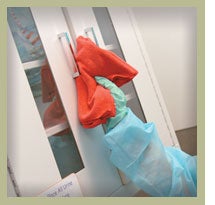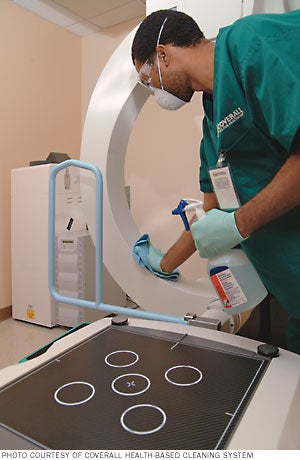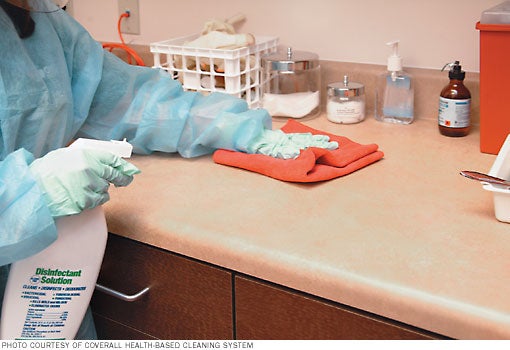Cleaning concerns
 To tackle the challenges of providing hygienically clean environments, ambulatory surgery centers (ASCs) need to implement science-based cleaning that focuses on both the removal of unwanted matter and proper surface disinfection. Surface disinfection and germ reduction need to be scientifically measured and tracked in order to provide useful data for cleaning staff and center management.
To tackle the challenges of providing hygienically clean environments, ambulatory surgery centers (ASCs) need to implement science-based cleaning that focuses on both the removal of unwanted matter and proper surface disinfection. Surface disinfection and germ reduction need to be scientifically measured and tracked in order to provide useful data for cleaning staff and center management.
The Centers for Disease Control and Prevention (CDC) notes how the overall transition of health care delivery from acute care hospitals to ASCs demonstrates a need for better implementation of basic infection prevention guidance. As the incidence of Methicillin-resistant Staphylococcus aureus (MRSA) and other dangerous pathogens continues to rise, ASCs need to focus on proper hygienic cleaning to help prevent infections among patients, visitors and staff.
The Journal of the American Medical Association (JAMA) recently reported that The Centers for Medicare & Medicaid Services (CMS) piloted an infection control audit tool in a sample of ASC inspections to assess the facilities' adherence to recommended practices.
Five different categories of infection control were assessed during the audit. Out of sixty-eight tested centers in three states that participated in the pilot program, nearly two-thirds were found to have serious lapses in one or more of the control categories. The different categories and the corresponding percentage of centers with lapses in that category included: hand hygiene and use of personal protective equipment (19.4 percent); injection safety and medication handling, including the use of single-dose vials for more than one patient (28.4 percent); equipment reprocessing including the reuse of single-use instruments with adequate sterilization and high-level disinfection (28.4 percent); environmental cleaning, including the cleaning of high-touch surfaces in patient-care areas (18.8 percent); and fully 46.3 percent of the centers lapsed in the handling and cleaning of blood glucose monitoring equipment.
These statistics, and other supporting studies, show that proper aseptic surface cleaning and disinfection techniques and protocols are an essential contributing factor in the prevention of healthcare-acquired infections and reducing morbidity and mortality associated with them.
Cleaning standards
Upholding standards of hygienic cleaning requires "cleaning for the unseen." In other words, surfaces might be visually gleaming, but may still harbor pathogens on the microbial level. "Clean" in all instances needs to reflect the absence of soil, unwanted matter and illness-causing germs, leaving surfaces in an aseptic state to reduce the risk of disease transmission.
Proper hygienic cleaning includes a blend of cleaning processes and effective surface disinfection, with particular attention to high-touch surfaces. Several studies indicate that cleaning with non-disinfecting agents and improper tools can actually increase the presence of illness-causing germs. This effect is even more pronounced when multiple areas are cleaned using the same cloth or mop, speeding the cross contamination of organisms even more effectively than human contact.
 |
| Effective soil removal requires advanced tools and equipment such as microfiber cloths. |
Key components of an effective, aseptic cleaning program include: killing harmful organisms through proper disinfection; containment and removal of unwanted matter; and scientific measurement to prove removal. Advanced cleaning processes and tools are required to achieve this.
Killing disease-causing organisms requires the selection of the right Environmental Protection Agency-registered, hospital-grade disinfectant for the job. Using the proper concentrations, with the proper dwell time, is the only effective way to deploy disinfectant agents.
Effective soil removal requires advanced tools and equipment such as color-coded microfiber technologies (for cleaning cloths and flat mops); multi-filtration, HEPA vacuums that filter soil, allergens and pathogens to .3 microns; and touch-free, spray-and-vac systems.
Terminal clean procedures
The Association of periOperative Registered Nurses (AORN) provides guidelines for thorough cleaning and disinfection of surgical environments. The fundamental elements of these guidelines are also applicable for any ASC area requiring an elevated level of cleaning and disinfection.
Proper terminal cleaning protocol requires that cleaning staff wear proper cleaning attire and personal protective equipment (PPE), including scrubs, gowns, hair net, gloves, face or eye protection and shoe covers. Hands should be thoroughly washed before beginning work. The cleaning products, prep equipment and chemicals should all be sufficiently wiped with disinfectant agents to reduce cross-contamination risks. Before cleaning, the staff should do a survey to identify special problems, such as the presence of blood or other bodily fluids. If detected, the staff should follow standard Occupational Safety and Health Administration-approved procedures required for bodily fluid clean up.
Proper protocol standards should also include special focus on high-touch point cleaning of door handles, light switches, phones, keyboards, etc., utilizing the proper color-coded microfiber (colors designated for individual areas of a facility) and hospital-grade disinfectant. Wall and ceiling areas should be cleaned with a microfiber flat mop that is wet with sufficient disinfectant solution and allowed proper dwell time. For floors, the area should be flood mopped and, after proper dwell time, the solution recovered using a wet/dry vacuum.
When executing terminal cleaning procedures, all movable items should be shifted to one side of the room to be cleaned, disinfected and moved back into position. For equipment that is moved on casters, cleaning staff should be sure to clean the casters themselves, and even roll them through an amount of disinfectant when moving back into position. Trash receptacles should be emptied and also thoroughly cleaned and disinfected.
At times there will be restrooms in areas that require terminal cleaning procedures. Restrooms with water-tolerant surfaces should be cleaned with advanced spray and vac systems in order to remove the most soil and matter. After applying approved disinfectant and allowing for sufficient dwell time, all surfaces are then rinsed at low pressure to avoid aerosolizing of pathogens and the solution is recovered through the integrated wet vacuum.
Scientifically measurable results
 |
| Ambulatory surgery centers are challenged to reduce pathogens and soils through a scientifically measurable process. |
For ASCs, it's important to track the effectiveness of the cleaning methods and their execution. A good first step in tracking effectiveness is to measure current contamination levels to establish a benchmark by which to gauge future tools, processes and service providers.
Since pathogens exist on the unseen level, true hygienic cleaning requires tools to help establish the efficacy of cleaning methods. One such tool is an ATP (Adenosine Triphosphate) meter, which detects the presence of ATP, the universal unit of energy used in all living cells. Nearly all cells contain some level of ATP, so the substance is a good universal marker of the presence of biological matter. It is important to note that ATP is not directly measuring the presence of pathogens; it measures the amount of organic material, which studies have indicated can be directly correlated to the presence of bacteria or other pathogens.
Testing using ATP is simple and can be used to quickly access the efficacy of cleaning methods. The user simply swabs the cleaned material (countertop, keyboard, floor, surgical table, etc.). The swab is treated with an enzyme to illuminate the ATP, and the swab is then inserted into a luminometer meter which typically displays results in seconds. The correlation between the amount of ATP and contamination levels is simple, more ATP simply means improper cleaning and high levels of bio-pollutants. Measurement of ATP provides cleaning staff and management with directly measurable data that can be used to make real-time decisions about cleaning, such as redirecting resources to areas with higher ATP readings.
Impact and effectiveness
For ASCs, there are several beneficial impacts after implementation of a measurable, aseptic cleaning protocol – including reduced levels of surface contamination and cross contamination. Gains in staff efficiency are also expected, as legitimate sick days from employee illnesses are reduced, which boosts morale and general staff well being. Ultimately the goal is to effectively impact and contribute to the prevention of healthcare-acquired infections.
If you should decide to outsource your surface cleaning function, hire a provider who is certified in hygienic cleaning processes for health care environments. Your provider should be willing and able to conduct a surface hygiene assessment with a scientific measurement device such as ATP and then design and recommend a protocol based on that data.
 |
| Proper aseptic surface cleaning can help reduce the spread of infection in health facilities. |
A provider who uses ATP testing will further help you to track and analyze the bio-pollutant data so trends can be discovered, and poor cleaning procedures or practices by staff can be corrected. Establish benchmarks, and then consistently implement every advance in cleaning to reduce soils and pathogen levels in your center for healthier patients, staff and visitors.
Peter J. Sheldon Sr., CBSE, is vice president of operations and development for Coverall Health-Based Cleaning System, Boca Raton, Fla. He can be reached at info@coverall.com



